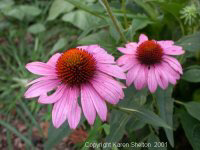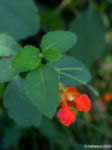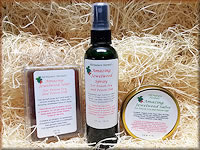The What, Where, When, How and Why of Echinacea
Copyright by The Garden
 For educational
information only. No parts of these documents, on this site or connected to this
site are to be taken as diagnosis or prescription for any illness. See your
Medical Healthcare for any personal health concerns.
For educational
information only. No parts of these documents, on this site or connected to this
site are to be taken as diagnosis or prescription for any illness. See your
Medical Healthcare for any personal health concerns.
Echinacea is an inhabitant of the plains regions of North America, where it has been used for millennia by the Native Americans. It is said that they used it for more purposes than any other plant group available to them. The root, leaves and flowers were used for everything from common flu and colds, insect and snake bites to treating cancer.
The early settlers learned of it's use from them and is known to have been utilized at least as early as the 1850's by doctors, particularly in an Herbal-based Medical School known as the "Eclectics". This School of Medicine finally closed it's doors in the 1930's, due to the growing power of the Allopathic School of Medicine and the discovery of penicillin. Before it's discovery, Echinacea was the most widely prescribed herb for all infections and inflammatory conditions. It should be noted here that it has never lost it's popularity in Europe.
There are three types of Echinacea used medicinally; Echinacea purpurea (Purple Coneflower), Echinacea pallida (Pale Purple Coneflower) and Echinacea augustifolia (Narrow-Leafed Purple Coneflower).
All the Echinacea have basically the same properties. There are many different chemical constituents within each variety, some have more of some, some have less. Some have a one or more the others don't. I am not going to go into an in-depth report on the different chemical compounds, for time as well as clarity’s sake, if you are interested in a serious scientific analysis of these elements, as well as their relationship to their healing properties, please refer to the book list, Christopher Hobb's book goes into it in depth. Because of both it's popularity and it's positive results seen in the medical community, Echinacea has been placed under very detailed analysis over the last one hundred years; in the last seventy mostly in Germany. However, in the last decade in this country it has been seriously studied and analyzed. This is good. Not only do we get a full understanding of why this herb does what it does and how we should use it; but it proves to the skeptics that there is scientific proof of Herbal Healing. it protects the consumer as we learn more about a plants properties; The mistake is when this information is used to regulate and prevent the consumer from obtaining an herb and the right to make their own decisions.
Still, with all the recent study the debate over which Echinacea is the best still continues; many Herbal Healers prefer angustifolia, claiming it is the strongest and most effective. Augustifolia and pallida have the same constituents, but pallida being in weaker concentrations, and due to it's capacity for bio-chemical breakdown, has a much shorter shelf life. As far as I can tell in my research, which herb to use is personal preference. However, over harvesting has resulted in a marked decrease in the wild angustifolia and so, it is recommended to purchase the more easily commercially grown purpurea. Over the last 100 years,50,000 to 100,000 pounds of wild crafted Echinacea has been exported to Europe. And now we are beginning to use an equal amount of this Herb domestically. Also, with wild crafted herbs, one is dependent on the hope that the harvester has a conscience, and not just with conservation in mind; many factors need to be met to insure that the herb you are purchasing is of good quality; was it harvested at the right time of year? the right time of day? the ideal growing conditions? was it even the right herb harvested? The FDA and Department of Agriculture allow a percentage for "adulterants", this is an amount allowed for misidentification and the intentional addition of similar species. For example, much of the wild crafted angustifolia has large amounts the less effective pallida in them (as well as other non-medicinally used Echinaceas) and this is perfectly acceptable to the present regulations. Couple this with over harvesting and a lot can be said for purchasing organic commercially grown herbs. Organic is emphasized, because then you can insure further the hope that your herbs have been grown in the proper conditions by persons with a little more awareness. Also, purpurea is generally less expensive than angustifolia due to it's being easier to cultivate. Purpurea is the one most commonly used in Europe and European preparations. Whether this is due to it's superior herbal properties or it being the most easiest cultivated is another debatable issue. One story is that a Doctor doing studies on Echinacea in the late 1800's in Germany order the seed of angustifolia for his studies. It wasn't until the herbs were growing that he found out he had been sent purpurea. He didn't let this stop him he continued his study and found that purpurea substituted perfectly for the uses he had in mind. That study is the basis for the European market and use of purpurea.
Echinacea's, though native to the plains region of North America, are easily grown in many areas. It's beautiful, almost magenta flowers are enough reason to add to your garden, but if you choose to grow it medicinally, and harvest the root, you should wait to harvest it no earlier than it's third year of growth and no later than it's fourth. This is when the chemical constituents are at their peak. The best way to insure this is to start your own seeds.
Echinacea seeds need to be stratified: that is given a time at being frozen. Either the seed packets, or the sown seed in growing medium are placed in the freezer or place outside. Direct seeding in Fall works well and is very easy.
To harvest any root, you wait until between the first frost and when you can no longer find the plant either due to total loss of foliage or you can't find it under the snow. The energies, sugars, starch and medicinal alkaloids are at their peak at this time as the plants ready themselves for dormancy for the winter. Ideally, another time to try and aim for when harvesting roots is in the waning moon, between the full moon and the new moon. This is the time when the moon is sending energies inward. This adds to the energy and so the medicinal alkaloids in the root system. You can harvest roots in the Spring but in my opinion not only is the plant "tired" out from surviving the Winter, but it doesn’t seem fair to dig it up after surviving the long cold Winter.
When you are harvesting leaves and flowers you do so between the new moon and the full, during the time of it's waxing and the moon is pulling energy outward. The best time of day to harvest flowers and leaves is in the mornings, on a clear sunny day right after the dew has dried. On average through out the growing season, between before 10:00 am and 11:00 am.
Teas, salves, liniments, and tinctures can be made out of the root, seeds and leaves and flowers. The root is the most widely used part. Though I like to make a tincture from the leaves and flowers in the summer months and after straining, use that tincture for the base of the root tincture
It is used for both internal and external uses as an anti-bacterial. It is said to be anti-viral, an alternative, lymphatic and as stimulate for saliva production. It is an excellent immune system tonic. It is said to be used for the treatment of blood poisoning, boils, abscesses, bacterial and viral infections. It is reported to be especially good for upper respiratory infections like tonsillitis, bronchitis and laryngitis and the treatment of fevers, colds and flu. It helps to rebuild damaged tissue, inhibits the growth of tumors and recently has been used in the treatments of candida. It is even reported to be insecticidal.
While large doses are noted to be not only safe but recommended in crisis and chronic illnesses, dosage for small children should be observed closely as it can cause them stomach irritation. For further information check out the books listed in the Bibliography below.
As with any herb the first time you start taking Echinacea in low then increasing doses. (See the article on Herbs and Toxicity)
The most widely recommend manner in which to take Echinacea is to start of with a low dose at the first sign of symptoms; about three times a day, increasing as needed to upward of every two hours, again decreasing as symptoms subside. The length of time depends on various reports but a generalization would be to stop after 3 – 4 weeks; starting again after a week if needed. It is in my opinion that if you are still that sick and haven’t consulted a Healthcare Practitioner of some type you should at that time.
With the new strains of virus developing due to the over use of anti-biotics the use of herbal immune stimulants is becoming increasingly important. This brings out the concept of the "cure all" or panacea. Occasionally, an herb, vitamin or other substance catches the attention of the population and is deemed the new "cure all". Twenty years ago it was Vitamin C. Now, this is an excellent vitamin and one that should, in my opinion be taken as needed. If you feel a "bug" coming on it helps to fight it off or alleviate the symptoms by taking Vitamin C. But it will not always cure you and I have found that when people take it and they still get sick or don't get better immediately, they claim it doesn't work at all. In the last few years Echinacea has taken the place of Vitamin C in this type of observation. It is possible if you are taking Echinacea and you still got sick that you possibly didn't take enough, or even that you were taking too much, it is also possible that no matter what you do you will still catch that bug. In that case Echinacea will help you fight off the extreme symptoms, but still that doesn't mean you won’t feel miserable or that it is not working. Echinacea helps you to build up the energy to fight off infections. Sometimes the body just has to go through with the symptoms and get on with things. So, the best thing for you to do is treat the symptoms and get on with things too. There are no "Cure Alls". The best way to stay healthy, in my opinion is a healthy diet, moderate exercise and drink plenty of fresh clean water; with the occasional use of herbs when needed.
One last thing to consider in herbal healing is that what will cure one person may not cure another, each of us is a unique individual and though we may have the same symptoms as another, the solution for it's alleviation will not necessarily be the same as someone else's. When treating an individual, it must be remembered that that persons problems are individual too. So if you have a friend where an herb helped them and it has done nothing for you, it doesn't mean herbal healing itself doesn't work, just that, that herb, for that problem wasn't the one for you. You have to keep searching and trying and eventually you will find your own unique solution.
Bibliography
Echinacea, The Immune Herb Christopher Hobbs, L.Ac. Botanica Press
The Way of Herbs Michael Tierra, C.A., N.D. Pocket Books
The Green Pharmacy James A. Duke, Ph.D. Rodale Press
School of Natural Healing Dr. John R. Christopher Christopher Publications
Peterson Field Guides
Eastern/Central Medicinal Plants Steven Foster and James Duke
Also see Echinacea article in our Herb Gallery





